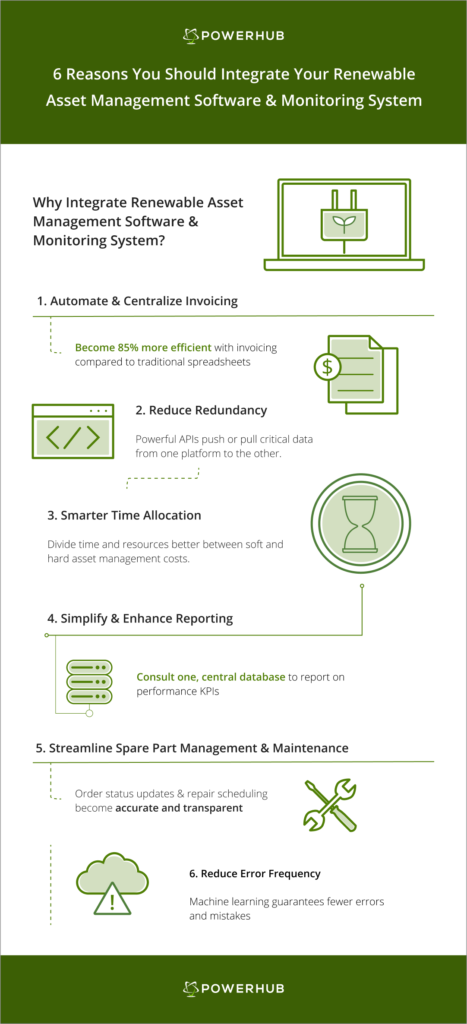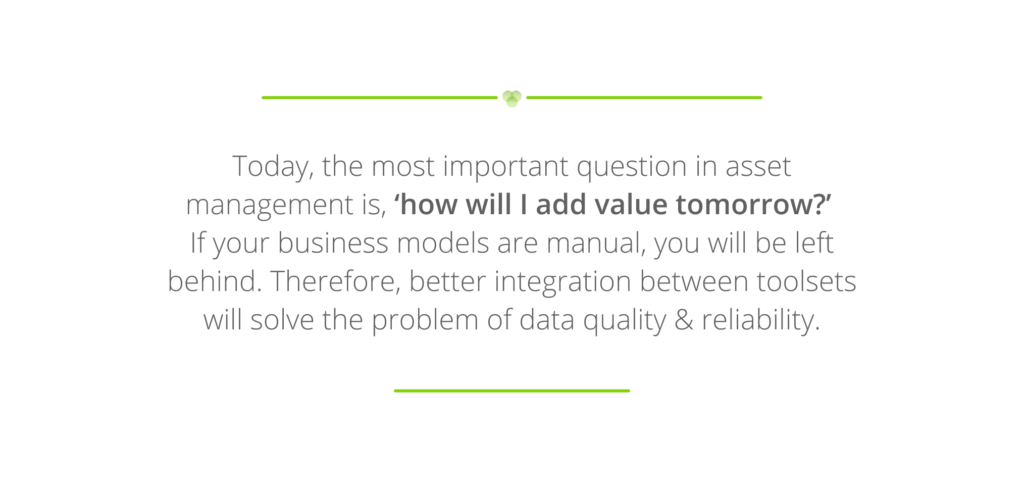When we talk about streamlining solar and wind projects, the first thing that comes to mind is software. Frankly, that’s what comes to our mind for pretty much everything (we call it the PowerHub effect!) … But really. Today, renewable energy asset management software has completely changed the landscape of clean energy production.
When we talk to our clients about how they’re managing assets, and some of their biggest pain points in the process, the conversation pretty much always points to one solution. Robust integrations.
We get it. Which is why, we constantly assert how beneficial a seamless integration between their renewable energy asset management software, and monitoring system can be. It really paves the way for powerful efficiencies.
For instance, the PowerHub platform has connected more than 20 DAS and SCADA systems through API integration. So, we confidently tell our clients to give it run. It’s simple, and it plays well.
Why Integrate Renewable Energy Asset Management Software & Monitoring System?
Technological innovation and advances in renewable asset management have reached a point where seamless integrations are within our reach. Thanks to best in class APIs, using multiple software to efficiently manage wind and solar farms no longer has to be a daunting task.
Wondering why we’re insisting on integrating your wind or solar asset management platform, and monitoring system?
Well then, let’s talk about the six most impactful reasons.

Automate & Centralize Invoicing
On the PowerHub blog, we’ve previously talked about some of our clients’ spending 40+ hours a month on invoicing. Our research indicates that energy asset management companies can become up to 85% more efficient if they use a smart software. Now imagine this efficiency if you automate and centralize invoicing – all thanks to integration.
Meter and grid injection data can be fed into a platform like PowerHub, which then schedules all invoicing in a matter of minutes. Isn’t that a lot of time on your hands now? Go ahead, try a new hobby.
Reduce Redundancy & Repetition
Repetition and redundancy are time sinkholes. They require too many resources tied up in activities that can easily be shortened or better yet, automated.
Hence, if your monitoring system is connected to your renewable energy asset management software via a powerful API, important data from one can be pushed or pulled into the latter.
As a result, the solar asset management platform can become your central information hub. It eliminates repetitive entry, and the need to manually update multiple platforms.
Smarter Time Allocation
According to Solar Energy Industries Association (SEIA), a 250MW utility-scale project spends up to 4 years in the development stage. During this time, at least 60% of total expenses are soft costs – including offtaker acquisition, financing, and installation. That’s a lot of time, and a lot of human effort to take it off the ground.
Which is why, using smart software platforms, and integrating them, is a great way to reduce time lags. The result? Streamlined workflows and quick decision making.
Simplify & Enhance Reporting
For a complex portfolio of wind and solar projects, reporting can be daunting. It may take days to gather data from various digital libraries and individual project files. You and your team would then analyze, and compile this information for monthly or quarterly reporting.
On the other hand, if you leverage the integration between a renewable energy asset management software and a monitoring system, reporting relies on one central, well- synced database. Your team consults this repository, analyzes data on one platform, and reports on key performance indicators.
Streamline Spare Part Management & Maintenance
Spare part ordering and maintenance is an essential asset management activity that has its own KPIs and scheduling. Since a number of stakeholders need this up-to-date information, syncing it across platforms improves accuracy. It also induces transparency by detailing order statuses and repair schedules.
Reduce Error Frequency
It’s simple. When you reduce the number of times your team must do data entry, you eliminate chances of errors exponentially. The beauty behind thoughtful APIs is that you let your machines do all the talking. They connect, coordinate, and complete the job even before you know it.
First Comes Digitalization…
Streamlining workflows with powerful integrations has been a top priority for asset managers lately, a trend we often seen in turbulent times. At PowerHub, we preach such digitalization so it’d become a norm – every day, all year round.

Therefore, digitalizing your management and monitoring strategy for solar and wind projects is the first step towards integration. For complex renewable energy portfolios, in particular, digitalization and platform integration is a powerful duo that makes the process of turning data into insights seamless.
How does your chosen platform help you take this leap? Honestly, that’s the biggest strength you should look for in a smart renewable energy asset management software.




